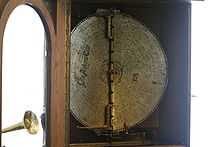Polyphon
Polyphon is the trade name of a disc-playing music box, a mechanical device first manufactured by the Polyphon Musikwerke, located in Leipzig, Germany. Invented in 1870, full-scale production started around 1897 and continued into the early 1900s. Polyphons were exported all over world and music was supplied for the English, French and German markets, as well as further afield, with music cataloged for the Russian, Polish and Balkan regions.
Original examples still exist, and contemporary manufacturers produce small quantities of both the devices and discs.

Making Music
The tune is punched out on the disc with pitch determined by the position of the punching. In the manufacturing process, the punched metal was curled back onto the underside of the disc, creating a raised projection that resembles a letter P when viewed obliquely. When the Polyphon operates, the resulting disc projections, called plectra, engage with a series of ratchet-like star wheels, each with 9 projections, that sit in a gantry. Each star wheel, when moved through 40 degrees on its axis, plucks a tooth on the instruments comb. The tooth then resonates, sounding a predetermined note.
Upon the musical comb, the fast treble notes are sounded furthest from the centre and the slower base notes nearest the centre. Many comb variants were manufactured, including a single comb on smaller instruments, and duplex combs (simultaneous strike) on mid-sized examples of 11-inch-diameter and 15.5-inch-diameter instruments. Most larger twin combed examples had alternate strike although other manufacturers, notably Symphonion, produced large size instruments with duplex combs.
Motor
Almost without exception, all Polyphons are powered by a hand-wound clockwork motor. Polyphon may have devised an electric motor variant of a large coin-operated model in the latter days of production, but to date, no known original examples exist. The motor has an output drive dog, which is a circular component with round-topped dowels arrange to fit the holes in the discs. Discs of small diameter have 2 centrally located holes (centre Drive), while larger discs had a series of holes around the periphery (peripheral drive).
During operation, a disc is placed on the centre post, or centre boss, a pressure bar goes over the disc to hold it in place and the drive dog revolves the disc. The playing time for each disc varies, dependent upon the diameter; for example, the running time of an 8-inch-diameter disc is about 1 minute and 50 seconds.
Modern availability
Numerous sizes of Polyphons and playing discs were produced, with a diameter ranging from 6 inches to a 24.5 inches. It is still possible to buy discs for the 24 1⁄2-inch-diameter Polyphon. A collection of 39 mostly new discs is being played regularly at Overbeck's National Trust property in Salcombe, Devon. The sound quality is very impressive.